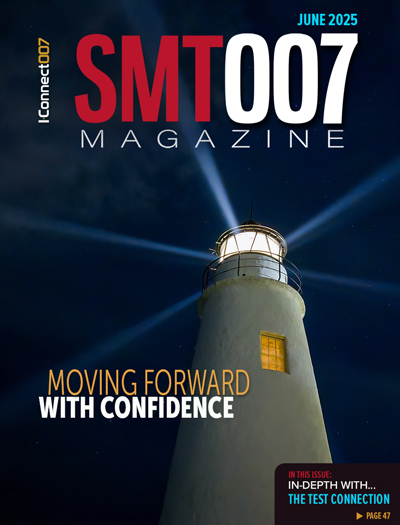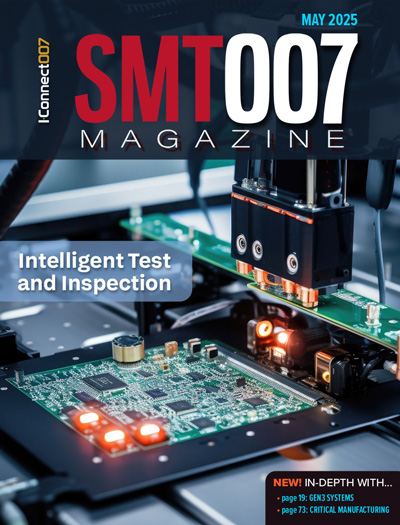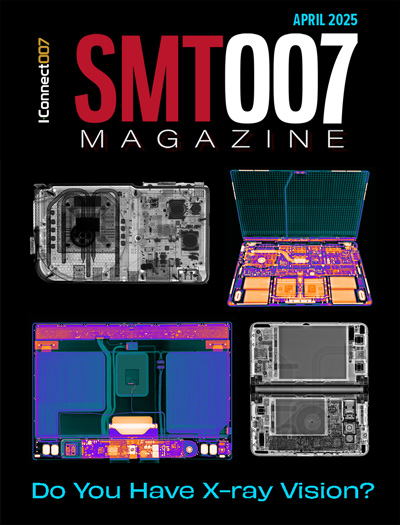-

- News
- Books
Featured Books
- smt007 Magazine
Latest Issues
Current Issue
Moving Forward With Confidence
In this issue, we focus on sales and quoting, workforce training, new IPC leadership in the U.S. and Canada, the effects of tariffs, CFX standards, and much more—all designed to provide perspective as you move through the cloud bank of today's shifting economic market.

Intelligent Test and Inspection
Are you ready to explore the cutting-edge advancements shaping the electronics manufacturing industry? The May 2025 issue of SMT007 Magazine is packed with insights, innovations, and expert perspectives that you won’t want to miss.

Do You Have X-ray Vision?
Has X-ray’s time finally come in electronics manufacturing? Join us in this issue of SMT007 Magazine, where we answer this question and others to bring more efficiency to your bottom line.
- Articles
- Columns
Search Console
- Links
- Media kit
||| MENU - smt007 Magazine
The Bill Comes Due: BOMs and the Digital Twin
September 29, 2021 | I-Connect007 Editorial TeamEstimated reading time: 4 minutes
The I-Connect007 Editorial Team recently discussed the subject of bill of material (BOM) with Michael Ford of Aegis Software. The conversation explored the current state of BOM creation, maintenance, and transfer, as well as the role BOMs play in product development and product life cycle. Naturally, attention also turned to the importance of the BOM within the digital twin.
Barry Matties: To start, would you give us your definition of a BOM?
Michael Ford: You must be very careful about what you mean when you mention the word “BOM.” There is the design BOM, where you will have the list of part numbers against the design intent, as determined by the designer, and maybe an associated AVL (Approved Vendor List) recommendation. Then you have the production BOM, derived from ERP, that reflects material part numbers selected by the purchasing team within the local manufacturer, which can often be different from those specified by design, with alternative and substituted parts, due to local availability, cost vs. performance issues, etc. The ERP BOM format usually features reference designators added almost like a comment to each part number record, the format of which can be quite variable and difficult to understand from a digital parsing perspective. On top of these challenges, you may also have variants of products where, for example, a product could have a single circuit board that is used in 100 different derivative models.
Do you really want to have to manage 100 different BOMs independently? At Aegis, we have comprehensive BOM management support that copes with these and other BOM-related issues very well. We have the concept of dynamic BOM, in which you have a single instance of a BOM, with defined choices for selected parts which are dependent on each specific product variant. This makes the management of the BOM where there are variants much more manageable, as there is simply one master BOM to maintain. So, the BOM is not just a simple list of part numbers and reference designators.
The essence of the practical problem is understanding what BOM data is ready to finally use. Data is coming from design, and is changed by the ERP material purchasing/selection process, which often continues right to the point the product goes into production. A central “live” BOM management strategy, as part of your engineering system, is essential. Decisions about whether a stocked or locally procured part could be used for a specific component reference with a product is based on complex data, and any alteration may need to go back for confirmation against the design intent, the AVL, or even back as a question to the designer.
The use of alternative materials is founded on necessary local procurement sourcing policy and material availability, but it introduces potential problems. There are times, for example, you think you’re ordering the same component from an alternate manufacturer or supplier, but you end up with a reel of parts which are at a 90-degree rotation offset in their carrier compared to those you normally use and have set up in the SMT machine databases. You may not notice this when receiving the materials, and so mixed orientations often make it through to the machines. In the best case, the machine will notice, and stop with an error saying that it can’t pick up these parts. What happened? The vendor changed and nobody realized there was anything different, and there was productivity loss. In the worst case, especially should the part be rotated by 180 degrees in the supply-form, the machine may not notice, resulting in serious quality issues. In the digital twin world, the exact shapes of the materials themselves are included. Therefore, automation is possible, from the receiving of materials through to the actual machine itself, where any exceptions would be highlighted, and automatic adjustment in machine databases made to reflect whatever differences there were, as each of the material carriers is uniquely labeled, and identified back to source.
This is doable right now within MES. The further you go digitizing these areas in the form of digital twin, the less manual work, especially checking, that must be done on the ground in manufacturing. Automating everything means that no mistakes will be made.
Matties: With the digital twin at the end of your design process, isn’t it just a press of a button and the BOM is created?
Ford: Yeah, that’s it. Now you’re done and everything beyond that should be automated in the digital factory.
Matties: The BOM is created, the intent is there, including all the revs. One quote we came across in our BOM research is a CEO of a company who said, “You built rev A, but it was the wrong rev A.” If there is a variation between model numbers in the digital twin, each item that is being built could theoretically have its own box.
Ford: Yes. I used to work in a company that makes high-end products in the consumer market. Their products have superb quality and performance, however, every day there were several BOM changes across products in production across the factory. You just never knew in advance what had to happen as a result. The manufacturing engineers and operators were heroes in coping with such a dynamic situation, making those products work the first time. It was leading edge product technology, supported by humans.
To read this entire conversation, which appeared in the September 2021 issue of SMT007 Magazine, click here.


